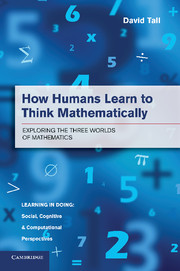Book contents
- Frontmatter
- Dedication
- Contents
- Series Foreword
- Journeys through three worlds of mathematics
- Preface
- Acknowledgements
- Illustration Credits
- I Prelude
- II School Mathematics and Its Consequences
- III Interlude
- IV University Mathematics and Beyond
- 10 The Transition to Formal Knowledge
- 11 Blending Ideas in the Calculus
- 12 Expert Thinking and Structure Theorems
- 13 Contemplating the Infinitely Large and Small
- 14 Expanding the Frontiers through Mathematical Research
- 15 Reflections
- Appendix Where It All Came From
- References
- Index
12 - Expert Thinking and Structure Theorems
from IV - University Mathematics and Beyond
Published online by Cambridge University Press: 05 June 2014
- Frontmatter
- Dedication
- Contents
- Series Foreword
- Journeys through three worlds of mathematics
- Preface
- Acknowledgements
- Illustration Credits
- I Prelude
- II School Mathematics and Its Consequences
- III Interlude
- IV University Mathematics and Beyond
- 10 The Transition to Formal Knowledge
- 11 Blending Ideas in the Calculus
- 12 Expert Thinking and Structure Theorems
- 13 Contemplating the Infinitely Large and Small
- 14 Expanding the Frontiers through Mathematical Research
- 15 Reflections
- Appendix Where It All Came From
- References
- Index
Summary
In this chapter we return to the journey through the axiomatic formal world. In Chapter 8 we saw the complication involved in the initial stages of formal deduction of a relationship such as (−a)(−b) = ab in an appropriate axiomatic system. In Chapter 10 we saw that first stage of dealing with definitions and deductions is highly complicated as learners attempt to make sense of the formal ideas when their minds are already full of embodied and symbolic ideas that must now be reorganized into formal definitions and proof.
Learners may develop in a variety of ways – as natural learners building structurally on embodied mental images of situations, or operationally on experiences manipulating symbols, or in a more formal way based on making deductions from formal definitions. Some may learn proofs procedurally to reproduce them in examinations.
When a learner is presented with a list of axioms, the first stage is to prove some initial theorems that enable the axioms and definitions to be used in more flexible ways. This develops from a multistructural list to a growing relational structure of formal knowledge. In the longer term it can become enriched as a crystalline concept.
- Type
- Chapter
- Information
- How Humans Learn to Think MathematicallyExploring the Three Worlds of Mathematics, pp. 338 - 360Publisher: Cambridge University PressPrint publication year: 2013

